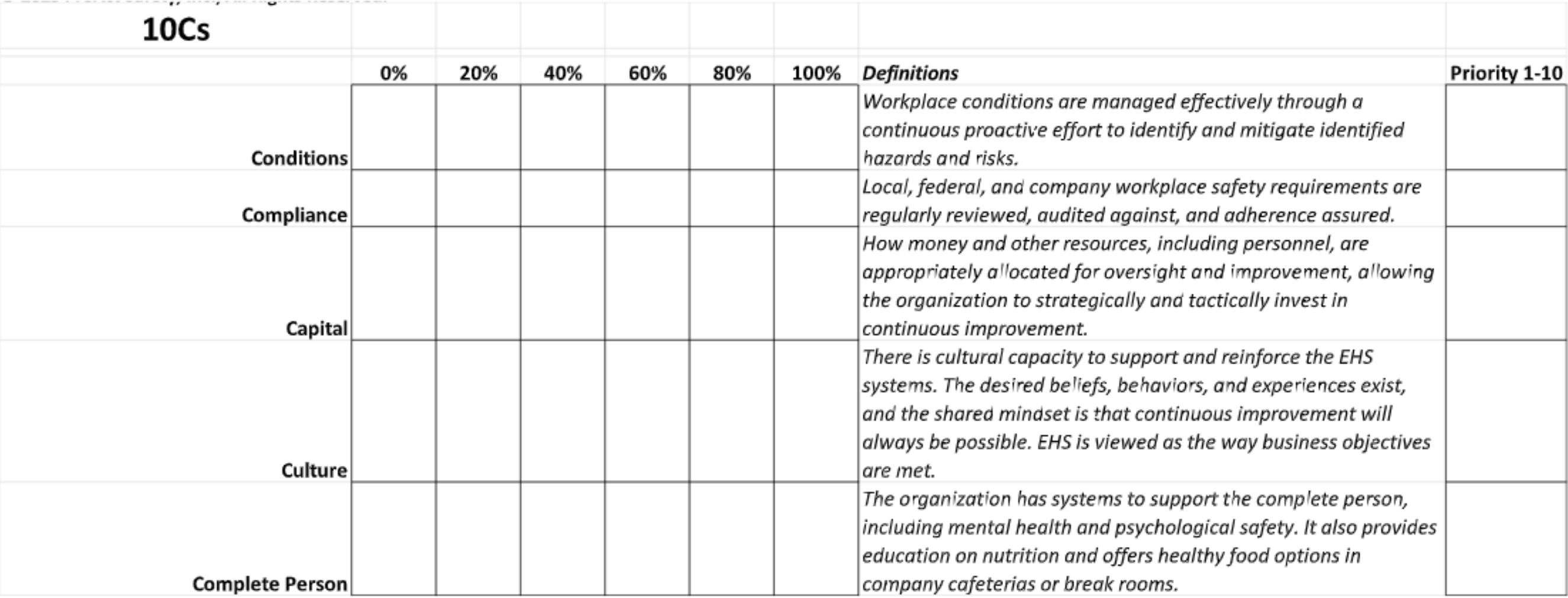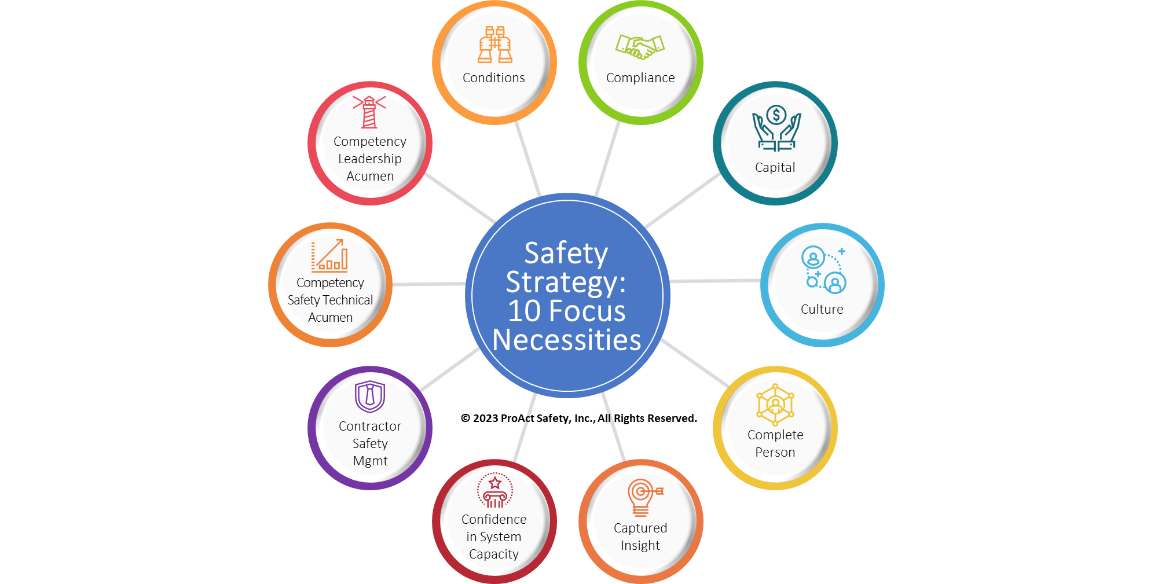Professional Safety - March 2024
By: Shawn M. Galloway
Printable Version
To achieve success in safety, there are ten areas in which organizations must focus energy and resources. However, few organizations have the bandwidth to excel in each area simultaneously.
Operational and safety leadership must evaluate the current state of these focus areas, then prioritize when to focus on each over the course of a multiyear strategy. This article explains these ten focus necessities and provides a guide on gathering perspectives from key stakeholders to prioritize an improvement plan or create a more robust safety improvement strategy.
Strategy is a framework of choices, trade-offs, and small bets that an organization makes to determine how to capture and deliver sustainable value. Whenever employee engagement is lacking or leaders apply insufficient time, cost, resources, and energy to improve safety, it typically stems from not recognizing the value in doing more than what is currently in place. Perceived value is the most significant factor in success or failure when working to improve performance and culture. For this reason, operational leadership input and education are vital to success. Some organizations appropriately recognize the importance of input from other key stakeholders such as employees, supervisors, and managers, which is the preferred method for developing plans or overall strategy.
Readers can share this article with organization leadership and other important stakeholders to start a conversation about these focus necessities. As stakeholders review each definition, ask them to give each focus necessity a score out of 100% for how well they believe each focus necessity is completely and effectively being addressed. Use these scores to then rank each from 1 to 10 in order of priority for what the leadership team should focus on first, second, third, and so forth. Figure 1 depicts a sample scoring template that can be used to measure each focus necessity in the workplace.

Defining the 10 Focus Necessities
Conditions — Workplace conditions are managed effectively through a continuous proactive effort to identify and mitigate identified hazards and risks.
Compliance — Local, federal, and company workplace safety requirements are regularly reviewed, and audited to assure adherence.
Capital — Money and other resources, including personnel, are appropriately allocated for oversight and improvement, allowing the organization to strategically and tactically invest in continuous improvement.
Culture — There is cultural capacity to support and reinforce the environmental health and safety (EHS) systems. The desired beliefs, behaviors, and experiences exist, and the shared mindset is that continuous improvement will always be possible. EHS is viewed as the way business objectives are met.
Complete Person — The organization has systems to support the complete person, including mental health and psychological safety. It also provides education on nutrition and offers healthy food options in company cafeterias or break rooms.

Captured Insight — Data collected and analyzed provides insight and allows safety and operational leadership to focus on strategic and tactical improvement in the other 9 areas.
Confidence in System Capacity — Capacity exists within the safety management system (hierarchy of controls) to prevent incidents and injuries. However, because human error is normal in complex environments and deviations from expectations will occur, the system also has recovery mechanisms to reduce the severity of unwanted events and bring the individual or operations back to the pre-event state. There is confidence in the system's capacity to prevent deviations from expectations and recovery systems to recover when deviations occur.
Contractor Safety Management — There is auditable proof that the approach is robust and effective across the five main phases of contractor safety management: prequalification, pre-job task and risk assessment, contractor training and orientation, monitoring of the job, and post-job evaluations.
Competency Safety Technical Acumen — All personnel in the organization maintain the necessary safety technical acumen to understand regulatory requirements and the safety expectations of the organization and how to achieve them. Everyone possesses the knowledge and competencies to perform their tasks in a way that supports the work as planned and contribute to an incident-free outcome.
Competency Leadership Acumen — All people leaders and influencers understand their role in supporting the safety strategy. These individuals work continuously to create a motivational environment that yields discretionary effort with safety activities. They know their people, understand how to get the best out of them, and recognize excellent performance and results.
Using the 10 Focus Necessities
Being strategic means focusing on the right things and ensuring the perception of value among participants or investors of your efforts. Occupational safety strategy must be a part of the overall business strategy, and business considerations must be a part of the safety strategy. When operational leadership is not involved in creating the strategy, there will be points of conflict. When it becomes the business strategy versus the safety strategy, we know who the winner will be. When other key workforce stakeholders are not involved in the discussion about areas on which to focus energy and resources and how to apply that focus, there will not be the level of buy-in, participation, or ownership necessary for the successful execution of the plan. When we are not focusing energy and resources in each of these ten necessary areas, our long-term strategy is not complete.
Leading a conversation on this model will be not only an opportunity to mature the safety excellence and strategic thinking of leadership, it will also help you identify how well the leadership team is aligned on the objectives and what it takes to accomplish them and become a necessary catalyst for continuous improvement.
Please contact the author to request a copy of the model and scoring template.

Shawn M. Galloway is the CEO of ProAct Safety and an advisor to leading organizations across all major industries. With over twenty years of experience in safety systems, strategy, culture, leadership, and employee engagement, he is a trusted advisor, keynote speaker, and expert witness.
He is the author of several bestselling books and has multiple regular columns in leading magazines, with over 400 articles and 100 videos to his credit. He also created the first safety podcast, Safety Culture Excellence, with over 800 episodes. Shawn has received numerous prestigious accolades and has been featured in Power 101 Leaders of the EHS World, Top 50 People Who Most Influenced EHS, Top 40 Rising Stars, Top 11 Health and Safety Influencers, and Top 10 Speakers.
He serves on the Harvard Business Review Advisory Council and the Fast Company Executive Board. He has appeared as a guest on Bloomberg, Fox News, The Daily Mail, Dubai One, U.S. News & World Report, Sirius Business Radio, Wharton Business Daily, and leading safety magazines and podcasts, reinforcing his status as an authority in the field of safety excellence.
For more information, call +1.936.273.8700 or email info@ProActSafety.com.
